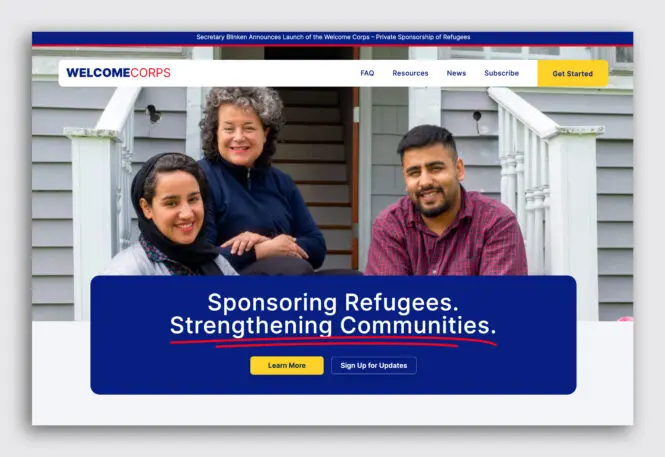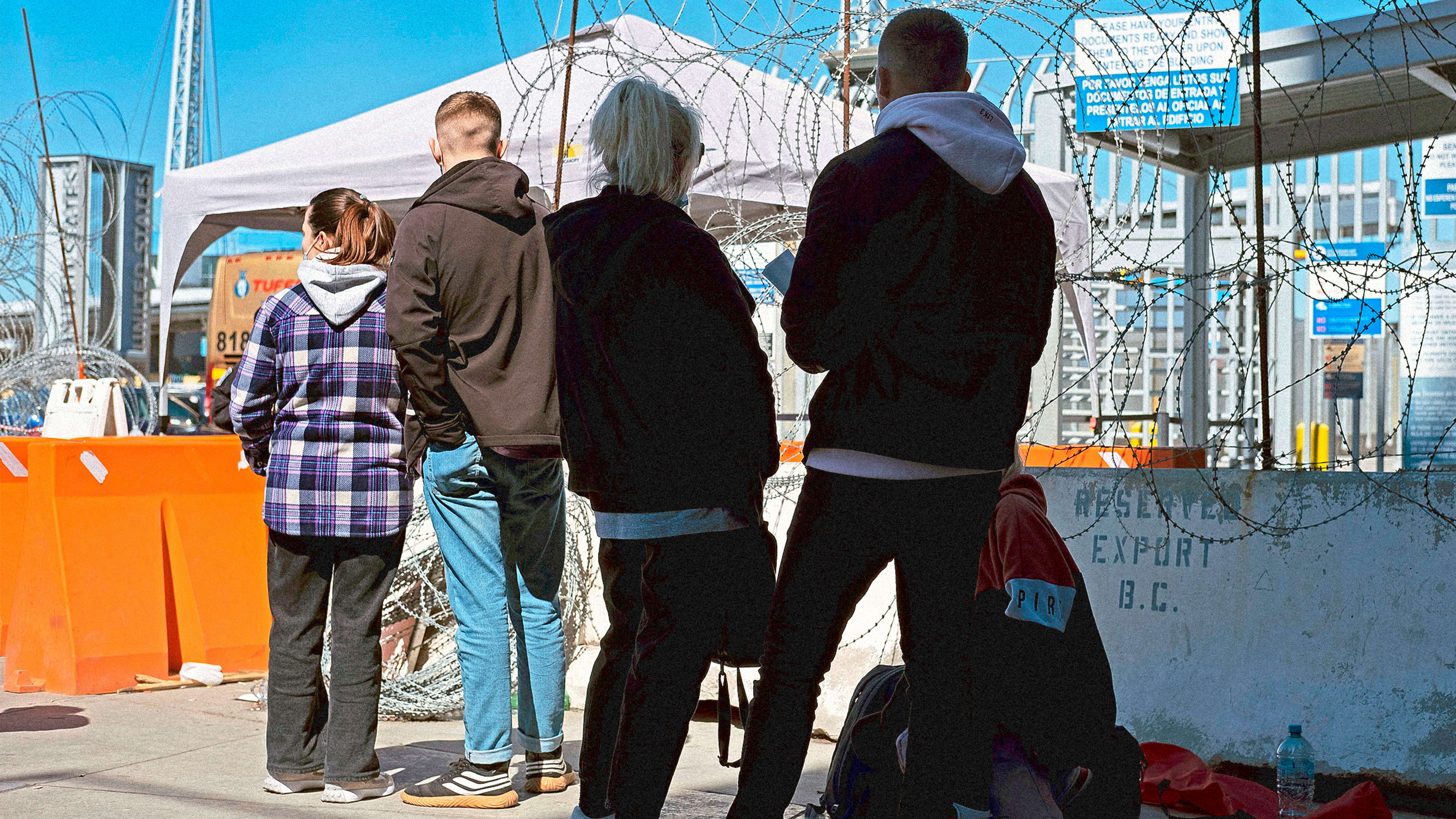John Schrager, an attorney in Minneapolis, can pinpoint the moment that he, his wife, Mary, and his daughters felt a true bond with the Ukrainian refugee family they are sponsoring. Less than two months into the arrangement, Schrager’s 17-year-old daughter received a text from the Ukrainian family’s 8-year-old girl. “Now I decide you are my cousin,” it read, in broken, Google-translated English. “John and Mary are my aunt and uncle. Because I love you very much.”
Now thousands more Americans will have a similar opportunity. The U.S. has launched the Welcome Corps, modeled on a Canadian system of resettlement that allows ordinary citizens to serve as private sponsors of incoming refugees, providing financial and moral support during the initial stages of their moves. Advocates say the model, now common in many developed countries including Australia and the U.K., will allow an increase in refugee admissions.
In the U.S., private sponsorship has its roots in smaller emergency programs established in recent years to welcome Afghan and Ukrainian refugees; in those programs, refugees and their sponsors have reported faster integration and a sense of fulfillment for the entire local community.

Since 1980, federal agencies have managed permanent resettlement in the U.S., vetting and approving resettlement requests while the refugees remain abroad (unlike asylum seekers, refugees currently live outside the country). When they’re on American soil, the government funds refugees’ early expenses, but they become largely the responsibility of local charities. The Welcome Corps will complement that system by also permitting private sponsorship.
Following the Canadian “group of five” system, citizens will need to form a cohort of at least five people to sponsor a refugee, creating a circle of support, increased community connections, and shared costs. “It could be anyone, so long as the group demonstrates the capacity and the willingness to provide those core private sponsorship services,” says Sarah Krause, executive director and cofounder of the Community Sponsorship Hub, one of the nonprofits the government has tasked with developing the infrastructure, implementing it, and connecting refugees and sponsors to the 200 nonprofits that help smooth the transition on the ground.
After matching with the refugees, and being vetted and trained, sponsors will be responsible for the refugees’ finances for their first 90 days in the U.S., a commitment of about $10,000 for a family of four. They will also help refugees find housing and jobs, and access essentials like education, healthcare, and transport. “Basically, what you need to do to get started in the United States,” Krause says.
In other words, ordinary citizens would be taking on the role of resettlement agencies, which Krause says “do heroic work” but are spread thin because of large caseloads. The private system generates a more immediate and personal tie between the refugee and the community. “You have five friends as soon as you step off the plane,” she says. “It can take a long time to make five friends in the United States as a newcomer otherwise.”
There seems to be a demand in the U.S. for a program like this. Community Sponsorship Hub’s first two information sessions included 5,000 people each, with more on waitlists. A new survey shows that nearly 7 in 10 Americans support the sponsorship model—and it crosses party lines. The program will allow Americans “to directly engage in this work, so they feel a sense of connection to it, and a responsibility for it,” Krause says.
In the past two years, emergency programs responding to the humanitarian crises in Afghanistan and Ukraine have served as inadvertent pilots for the Welcome Corps. Though the Ukrainian program, Uniting for Ukraine, involves two-year sponsorships in the U.S. as opposed to permanent settlement, it has a similar sponsor model.
Schrager, the Minnesota lawyer, decided to sponsor a Ukrainian family after he saw an email from Alight, a humanitarian nonprofit supporting the transitions. He recruited four others to help sponsor the family: a retired city worker, another attorney, an HR professional, and his wife, Mary.
The process started “a little bit like dating,” Schrager says, in that they had to post a profile ad. It caught the attention of a family of five who’d fled from Dnpiro, Ukraine, to Trieste, Italy, where they were all staying in a one-room apartment with a hot plate. “They were feeding them and keeping them safe,” he says, “but it wasn’t a place to raise a family.”
He had multiple back-and-forths on WhatsApp (with the aid of Google Translate) with the mother, Olesia, to build trust. “If you think about it, I was just a stranger she met on the internet,” Schrager says. The family flew into the Twin Cities on December 5 and went to an apartment in a St. Paul suburb that Schrager had cosigned for and furnished on their behalf.
“It is a fair amount of work,” he says. But while the financial responsibility is on the sponsors, the wider community has been overwhelmingly supportive, he says, and donated $10,000, a car, and furniture. A 93-year-old family friend who isn’t going to fly anymore donated her American Airlines air miles.
Money aside, sponsors are also expected to help with the social transition. Alight offers “guides” for support. The Schragers’ guide, Anatoliy Cherednichenko, a senior at Macalester College in St. Paul, serves as a cultural ambassador—a “one-stop shop,” he says, for navigating any cultural and linguistic barriers. He also holds Zoom forums every week for sponsors to share their experiences. “I’m still just impressed by how much kindness is out there,” Cherednichenko says.
As the Welcome Corps rolls out, the processes should be similar. But instead of Afghan and Ukrainian refugees, the program will start by welcoming refugees from sub-Saharan Africa, which has the largest caseload and has been neglected during recent crises. It will expand to other locations soon after.
The Welcome Corps will have two phases: In the first, sponsors will match with a refugee who has already been approved; in the second, after six months Americans will be able to sponsor someone they might know, such as a relative, distant friend, or someone identified by a nonprofit as particularly at risk.
The first phase aims to clear up a backlog of people who are already approved but haven’t been resettled. Former President Donald Trump severely reduced the refugee admissions ceiling, from 110,000 in 2017 to 18,000 in 2020; while President Joe Biden raised it to 125,000, the U.S. admitted fewer than 12,000 refugees in 2021 due to processing delays.
As long as processing accelerates, advocates believe the Welcome Corps will increase admissions because there will be a greater capacity to identify refugees and more people to resettle them. The State Department aims to recruit 10,000 sponsors and settle 5,000 refugees as part of the program in the first year.
Schrager says the Ukrainian family he’s helping to sponsor has made clear progress in the two months since their arrival. “You have a family of five that is not just alive and safe, but they’re thriving,” he says. The two families celebrated Christmas together (with shopping trips to the Mall of America), and now are settling into more of a daily routine. Because Schrager is helping financially—with the aid of a matching grant from Lutheran Social Services, a local nonprofit—they are able to focus on language and driving lessons for the father, Serhii, before tackling job hunting.
After six months, when the grant runs out, they’ll have to be economically self-sufficient. Serhii is a trained lawyer and police officer, but is willing to work as a delivery driver for Amazon or UPS. “There’s so many unfilled jobs in this country right now that would benefit from great hard workers,” says Jocelyn Wyatt, Alight’s CEO.
As for the rest of the family: Olesia cooks and looks after their baby; the 14-year-old boy is in judo classes; and the 8-year-old takes dance lessons from Schrager’s daughter, with whom she’s formed a bond. They’re in school full time and are making friends. In downtime, friends of the Schragers have invited them to watch Vikings games and go ice fishing. “They came to us pretty shell-shocked,” Schrager says, “and now they’re living life again.”
But the benefits have been mutual. “I would say that we’ve gotten far more out of it than we put into in,” Schrager says. His family, and the whole community, has learned much about the plight of refugees. “There is nothing like a personal connection with a group in order to humanize them, to make people see them as people,” he says.
The Welcome Corps will give even more communities the chance to come together to uplift individuals’ lives after considerable trauma. “We’re building this decentralized team of Americans who are empowered to welcome people in to make a better community,” Schrager says. “An ordinary person can transform a life.”
Recognize your brand’s excellence by applying to this year’s Brands That Matter Awards before the early-rate deadline, May 3.
